Global or Local Spatial Spillovers? Industrial Diversity and Economic Resilience in the Middle Reaches of the Yangtze River Urban Agglomeration, China
Abstract
1. Introduction
2. Literature Review
2.1. The Concepts and Measurements of Economic Resilience
2.2. Industrial Structure and Regional Economic Resilience
2.3. Global Versus Local Spatial Spillovers
3. Study Region
4. Methods
4.1. Measuring Economic Resilience
4.2. Measuring Industrial Variety
4.3. The Empirical Model
4.4. The Role of Spatial Spillovers
5. Results and Discussion
5.1. Preliminary Analysis
5.2. Regression Analysis
6. Conclusions
Author Contributions
Funding
Institutional Review Board Statement
Informed Consent Statement
Data Availability Statement
Acknowledgments
Conflicts of Interest
References
- Annoni, P.; Dominicis, L.; Khabirpour, N. Location Matters: A Spatial Econometric Analysis of Regional Resilience in the European Union. Growth Change 2019, 50, 824–855. [Google Scholar] [CrossRef]
- Boschma, R. Towards an Evolutionary Perspective on Regional Resilience. Reg. Stud. 2015, 49, 733–751. [Google Scholar] [CrossRef]
- Bristow, G.; Healy, A. Innovation and Regional Economic Resilience: An Exploratory Analysis. Ann. Reg. Sci. 2018, 60, 265–284. [Google Scholar] [CrossRef]
- Martin, R.; Sunley, P.; Gardiner, B.; Tyler, P. How Regions React to Recessions: Resilience and the Role of Economic Structure. Reg. Stud. 2016, 50, 561–585. [Google Scholar] [CrossRef]
- Xiao, J.; Boschma, R.; Andersson, M. Industrial Diversification in Europe: The Differentiated Role of Relatedness. Econ. Geogr. 2018, 94, 514–549. [Google Scholar] [CrossRef]
- Glaeser, E.L.; Kallal, H.D.; Scheinkman, J.A.; Shleifer, A. Growth in Cities. J. Polit. Econ. 1992, 100, 1126–1152. [Google Scholar] [CrossRef]
- De Groot, H.L.F.; Poot, J.; Smit, M.J. Which agglomeration externalities matter most and why?: Importance of agglomeration externalities. J. Econ. Surv. 2016, 30, 756–782. [Google Scholar] [CrossRef]
- Marshall, A. Principles of Economics Macmillan, 8th ed.; Macmillan and Co.: London, UK, 1890. [Google Scholar]
- Duranton, G.; Puga, D. Micro-Foundations of Urban Agglomeration Economies; National Bureau of Economic Research: Cambridge, MA, USA, 2003; p. w.9931. [Google Scholar]
- Frenken, K.; Van Oort, F.; Verburg, T. Related Variety, Unrelated Variety and Regional Economic Growth. Reg. Stud. 2007, 41, 685–697. [Google Scholar] [CrossRef]
- Cainelli, G.; Ganau, R.; Modica, M. Industrial Relatedness and Regional Resilience in the European Union. Pap. Reg. Sci. 2019, 98, 755–778. [Google Scholar] [CrossRef]
- He, C.; Chen, T.; Zhu, S. Do Not Put Eggs in One Basket: Related Variety and Export Resilience in the Post-Crisis Era. Ind. Corp. Chang. 2022, 30, 1655–1676. [Google Scholar] [CrossRef]
- Jackson, R.W. An Evaluation of Alternative Measures of Regional Industrial Diversification. Reg. Stud. 1984, 18, 103–112. [Google Scholar] [CrossRef]
- Trendle, B. Regional Economic Instability: The Role of Industrial Diversification and Spatial Spillovers. Ann. Reg. Sci. 2006, 40, 767–778. [Google Scholar] [CrossRef]
- Deller, S.; Watson, P. Did Regional Economic Diversity Influence the Effects of the Great Recession? Diversity, Stability, and the Great Recession. Econ. Inq. 2016, 54, 1824–1838. [Google Scholar] [CrossRef]
- Grabner, S.M.; Modica, M. Industrial Resilience, Regional Diversification and Related Variety during Times of Crisis in the US Urban–Rural Context. Reg. Stud. 2022, 56, 1605–1617. [Google Scholar] [CrossRef]
- Cainelli, G.; Ganau, R.; Modica, M. Does Related Variety Affect Regional Resilience? New Evidence from Italy. Ann. Reg. Sci. 2019, 62, 657–680. [Google Scholar] [CrossRef]
- Chen, J. The Impact of Cluster Diversity on Economic Performance in U.S. Metropolitan Statistical Areas. Econ. Dev. Q. 2020, 34, 46–63. [Google Scholar] [CrossRef]
- Tobler, W.R. A Computer Movie Simulating Urban Growth in the Detroit Region. Econ. Geogr. 1970, 46, 234. [Google Scholar] [CrossRef]
- LeSage, J.P. What Regional Scientists Need to Know about Spatial Econometrics. Rev. Reg. Stud. 2014, 44, 13–32. [Google Scholar]
- Chen, J. Geographical Scale, Industrial Diversity, and Regional Economic Stability. Growth Change 2019, 50, 609–633. [Google Scholar] [CrossRef]
- Holling Resilience and Stability of Ecological Systems. Annu. Rev. Ecol. Syst. 1973, 4, 1–23. [CrossRef]
- Simmie, J.; Martin, R. The Economic Resilience of Regions: Towards an Evolutionary Approach. Camb. J. Reg. Econ. Soc. 2010, 3, 27–43. [Google Scholar] [CrossRef]
- Tan, J.; Hu, X.; Hassink, R.; Ni, J. Industrial Structure or Agency: What Affects Regional Economic Resilience? Evidence from Resource-Based Cities in China. Cities 2020, 106, 102906. [Google Scholar] [CrossRef]
- Gong, H.; Hassink, R.; Tan, J.; Huang, D. Regional Resilience in Times of a Pandemic Crisis: The Case of COVID-19 in China. Tijdschr. Voor Econ. En Soc. Geogr. 2020, 111, 497–512. [Google Scholar] [CrossRef] [PubMed]
- Hu, X.; Li, L.; Dong, K. What Matters for Regional Economic Resilience amid COVID-19? Evidence from Cities in Northeast China. Cities 2022, 120, 103440. [Google Scholar] [CrossRef] [PubMed]
- Brown, L.; Greenbaum, R.T. The Role of Industrial Diversity in Economic Resilience: An Empirical Examination across 35 Years. Urban Stud. 2017, 54, 1347–1366. [Google Scholar] [CrossRef]
- Martin, R. Regional Economic Resilience, Hysteresis and Recessionary Shocks. J. Econ. Geogr. 2012, 12, 1–32. [Google Scholar] [CrossRef]
- Lagravinese, R. Economic Crisis and Rising Gaps North-South: Evidence from the Italian Regions. Camb. J. Reg. Econ. Soc. 2015, 8, 331–342. [Google Scholar] [CrossRef]
- Martin, R.; Sunley, P. On the Notion of Regional Economic Resilience: Conceptualization and Explanation. J. Econ. Geogr. 2015, 15, 1–42. [Google Scholar] [CrossRef]
- Doran, J.; Fingleton, B. US Metropolitan Area Resilience: Insights from Dynamic Spatial Panel Estimation. Environ. Plan. Econ. Space 2018, 50, 111–132. [Google Scholar] [CrossRef]
- Rocchetta, S.; Mina, A.; Lee, C.; Kogler, D.F. Technological Knowledge Spaces and the Resilience of European Regions. J. Econ. Geogr. 2022, 22, 27–51. [Google Scholar] [CrossRef]
- Di Caro, P. Recessions, Recoveries and Regional Resilience: Evidence on Italy. Camb. J. Reg. Econ. Soc. 2015, 8, 273–291. [Google Scholar] [CrossRef]
- Attaran, M. Industrial Diversity and Economic Performance in U.S. Areas. Ann. Reg. Sci. 1986, 20, 44–54. [Google Scholar] [CrossRef]
- Hidalgo, C.A.; Klinger, B.; Barabási, A.-L.; Hausmann, R. The Product Space Conditions the Development of Nations. Science 2007, 317, 482–487. [Google Scholar] [CrossRef]
- Kogler, D.F.; Rigby, D.L.; Tucker, I. Mapping Knowledge Space and Technological Relatedness in US Cities. Eur. Plan. Stud. 2013, 21, 1374–1391. [Google Scholar] [CrossRef]
- Fan, J.P.H.; Lang, L.H.P. The Measurement of Relatedness: An Application to Corporate Diversification. J. Bus. 2000, 73, 629–660. [Google Scholar] [CrossRef]
- Guo, Q.; He, C.; Li, D. Entrepreneurship in China: The Role of Localisation and Urbanisation Economies. Urban Stud. 2016, 53, 2584–2606. [Google Scholar] [CrossRef]
- Lacombe, D.J.; Holloway, G.J.; Shaughnessy, T.M. Bayesian Estimation of the Spatial Durbin Error Model with an Application to Voter Turnout in the 2004 Presidential Election. Int. Reg. Sci. Rev. 2014, 37, 298–327. [Google Scholar] [CrossRef]
- Audretsch, D.B.; Feldman, M.P. R&D Spillovers and the Geography of Innovation and Production. Am. Econ. Rev. 1996, 86, 630–640. [Google Scholar]
- Anselin, L.; Varga, A.; Acs, Z. Local Geographic Spillovers between University Research and High Technology Innovations. J. Urban Econ. 1997, 42, 422–448. [Google Scholar] [CrossRef]
- Bahar, D.; Hausmann, R.; Hidalgo, C.A. Neighbors and the Evolution of the Comparative Advantage of Nations: Evidence of International Knowledge Diffusion? J. Int. Econ. 2014, 92, 111–123. [Google Scholar] [CrossRef]
- Boschma, R.; Martín, V.; Minondo, A. Neighbour Regions as the Source of New Industries: Neighbour Regions as the Source of New Industries. Pap. Reg. Sci. 2017, 96, 227–245. [Google Scholar] [CrossRef]
- Zhu, S.; He, C.; Luo, Q. Good Neighbors, Bad Neighbors: Local Knowledge Spillovers, Regional Institutions and Firm Performance in China. Small Bus. Econ. 2019, 52, 617–632. [Google Scholar] [CrossRef]
- Gao, J.; Jun, B.; Pentland, A.S.; Zhou, T.; Hidalgo, C.A. Spillovers across Industries and Regions in China’s Regional Economic Diversification. Reg. Stud. 2021, 55, 1311–1326. [Google Scholar] [CrossRef]
- Goodchild, M.F.; Anselin, L.; Appelbaum, R.P.; Harthorn, B.H. Toward spatially integrated social science. Int. Reg. Sci. Rev. 2000, 23, 139–159. [Google Scholar] [CrossRef]
- Läpple, D.; Holloway, G.; Lacombe, D.J.; O’Donoghue, C. Sustainable Technology Adoption: A Spatial Analysis of the Irish Dairy Sector. Eur. Rev. Agric. Econ. 2017, 44, 810–835. [Google Scholar] [CrossRef]
- Mannaf, M.; Wheeler, S.A.; Zuo, A. Global and Local Spatial Spill-Overs: What Matters Most for the Diffusion of Organic Agriculture in Australia? Ecol. Econ. 2023, 209, 107835. [Google Scholar] [CrossRef]
- Kopczewska, K.; Kudła, J.; Walczyk, K. Strategy of Spatial Panel Estimation: Spatial Spillovers Between Taxation and Economic Growth. Appl. Spat. Anal. Policy 2017, 10, 77–102. [Google Scholar] [CrossRef]
- Guan, H.; Liu, W.; Zhang, P.; Lo, K.; Li, J.; Li, L. Analyzing Industrial Structure Evolution of Old Industrial Cities Using Evolutionary Resilience Theory: A Case Study in Shenyang of China. Chin. Geogr. Sci. 2018, 28, 516–528. [Google Scholar] [CrossRef]
- Zheng, W.; Kuang, A.; Wang, X.; Chen, J. Measuring Network Configuration of the Yangtze River Middle Reaches Urban Agglomeration: Based on Modified Radiation Model. Chin. Geogr. Sci. 2020, 30, 677–694. [Google Scholar] [CrossRef]
- Anselin, L. Lagrange Multiplier Test Diagnostics for Spatial Dependence and Spatial Heterogeneity. Geogr. Anal. 2010, 20, 1–17. [Google Scholar] [CrossRef]
- Giannakis, E.; Mamuneas, T.P. Labour Productivity and Regional Labour Markets Resilience in Europe. Ann. Reg. Sci. 2022, 68, 691–712. [Google Scholar] [CrossRef]
- LeSage, J.P. Software for Bayesian Cross Section and Panel Spatial Model Comparison. J. Geogr. Syst. 2015, 17, 297–310. [Google Scholar] [CrossRef]
- LeSage, J.; Pace, R.K. Introduction to Spatial Econometrics; Chapman and Hall/CRC: Boca Raton, FL, USA, 2009. [Google Scholar]
- Jensen, C.D.; Lacombe, D.J.; McIntyre, S.G. A Bayesian Spatial Econometric Analysis of the 2010 UK General Election: Spatial Analysis of UK Voting. Pap. Reg. Sci. 2012, 92, 651–666. [Google Scholar] [CrossRef]
- Sedita, S.R.; De Noni, I.; Pilotti, L. Out of the Crisis: An Empirical Investigation of Place-Specific Determinants of Economic Resilience. Eur. Plan. Stud. 2017, 25, 155–180. [Google Scholar] [CrossRef]
- Diodato, D.; Weterings, A.B.R. The Resilience of Regional Labour Markets to Economic Shocks: Exploring the Role of Interactions among Firms and Workers. J. Econ. Geogr. 2015, 15, 723–742. [Google Scholar] [CrossRef]
- Kao, S.Y.-H.; Bera, A.K. Spatial Regression: The Curious Case of Negative Spatial Dependence; University of Illinois: Champaign, IL, USA, 2016. [Google Scholar]
- Balland, P.-A.; Boschma, R.; Crespo, J.; Rigby, D.L. Smart Specialization Policy in the European Union: Relatedness, Knowledge Complexity and Regional Diversification. Reg. Stud. 2019, 53, 1252–1268. [Google Scholar] [CrossRef]
- Jara-Figueroa, C.; Jun, B.; Glaeser, E.L.; Hidalgo, C.A. The Role of Industry-Specific, Occupation-Specific, and Location-Specific Knowledge in the Growth and Survival of New Firms. Proc. Natl. Acad. Sci. USA 2018, 115, 12646–12653. [Google Scholar] [CrossRef] [PubMed]
- Wixe, S.; Andersson, M. Which Types of Relatedness Matter in Regional Growth? Industry, Occupation and Education. Reg. Stud. 2017, 51, 523–536. [Google Scholar] [CrossRef]
- Moro, E.; Frank, M.R.; Pentland, A.; Rutherford, A.; Cebrian, M.; Rahwan, I. Universal Resilience Patterns in Labor Markets. Nat. Commun. 2021, 12, 1972. [Google Scholar] [CrossRef] [PubMed]
- Cuaresma, J.C.; Doppelhofer, G.; Feldkircher, M. The Determinants of Economic Growth in European Regions. Reg. Stud. 2014, 48, 44–67. [Google Scholar] [CrossRef]
- LeSage, J.P.; Parent, O. Bayesian Model Averaging for Spatial Econometric Models. Geogr. Anal. 2007, 39, 241–267. [Google Scholar] [CrossRef]
- Watson, P.; Deller, S. Economic Diversity, Unemployment and the Great Recession. Q. Rev. Econ. Finance 2017, 64, 1–11. [Google Scholar] [CrossRef]
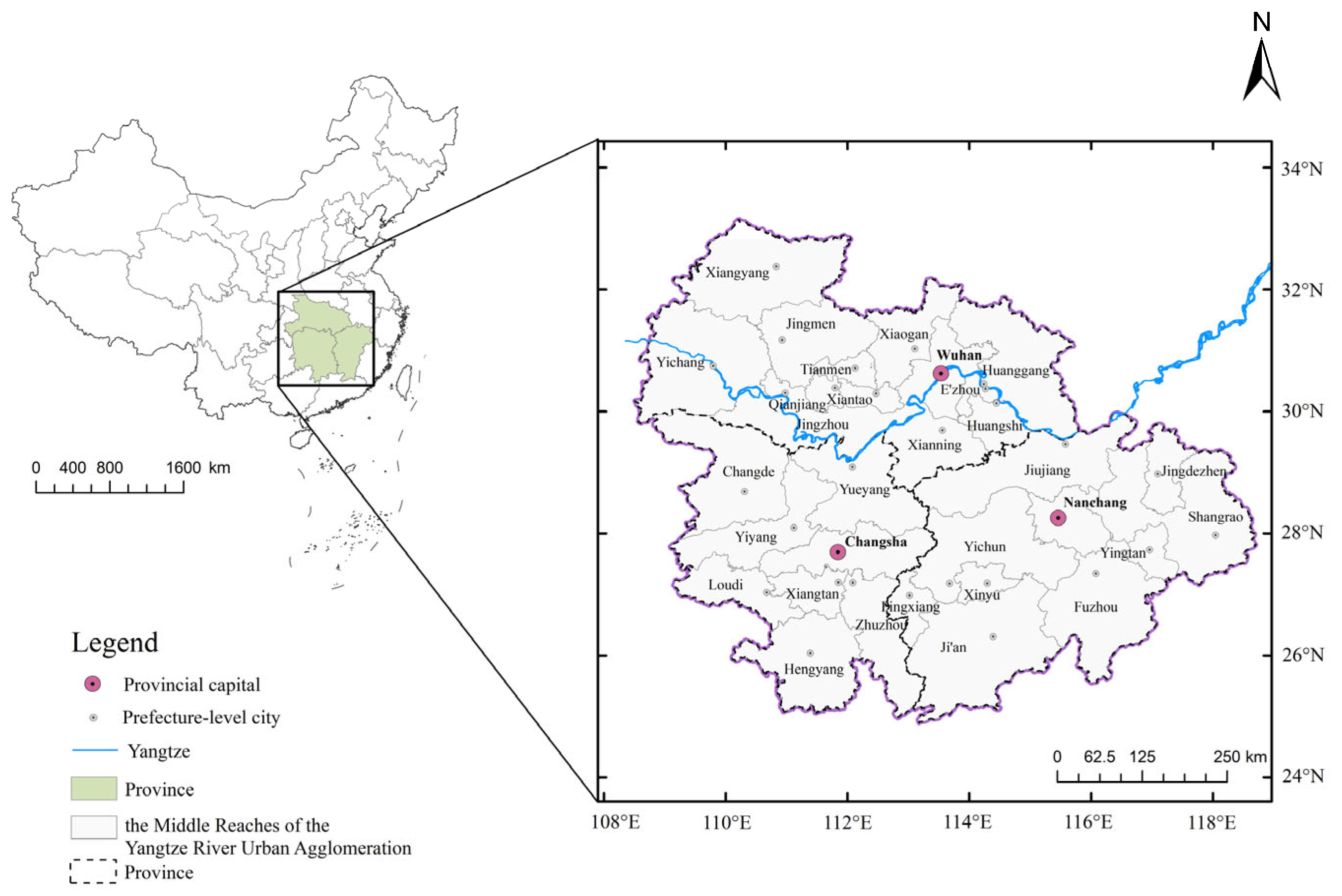
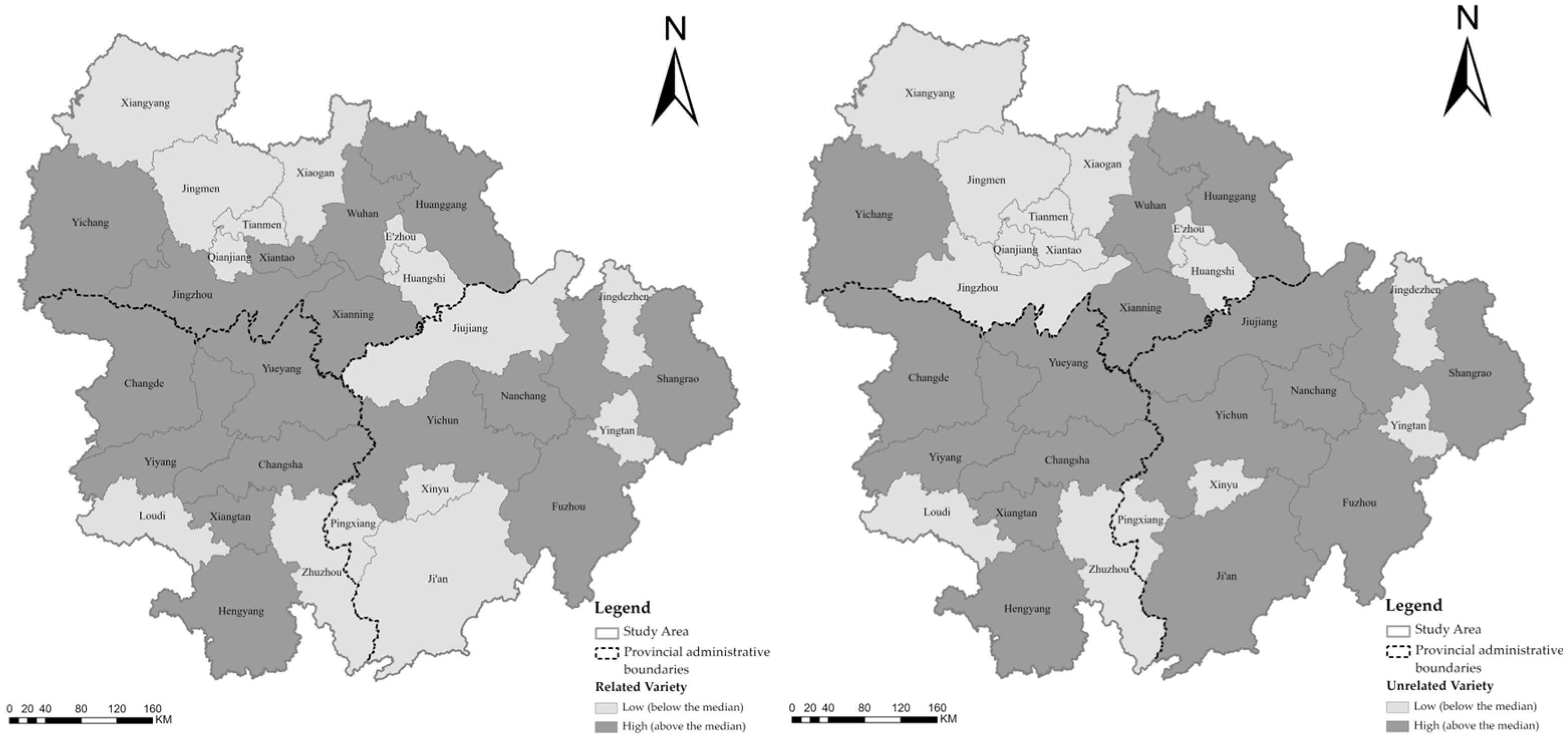
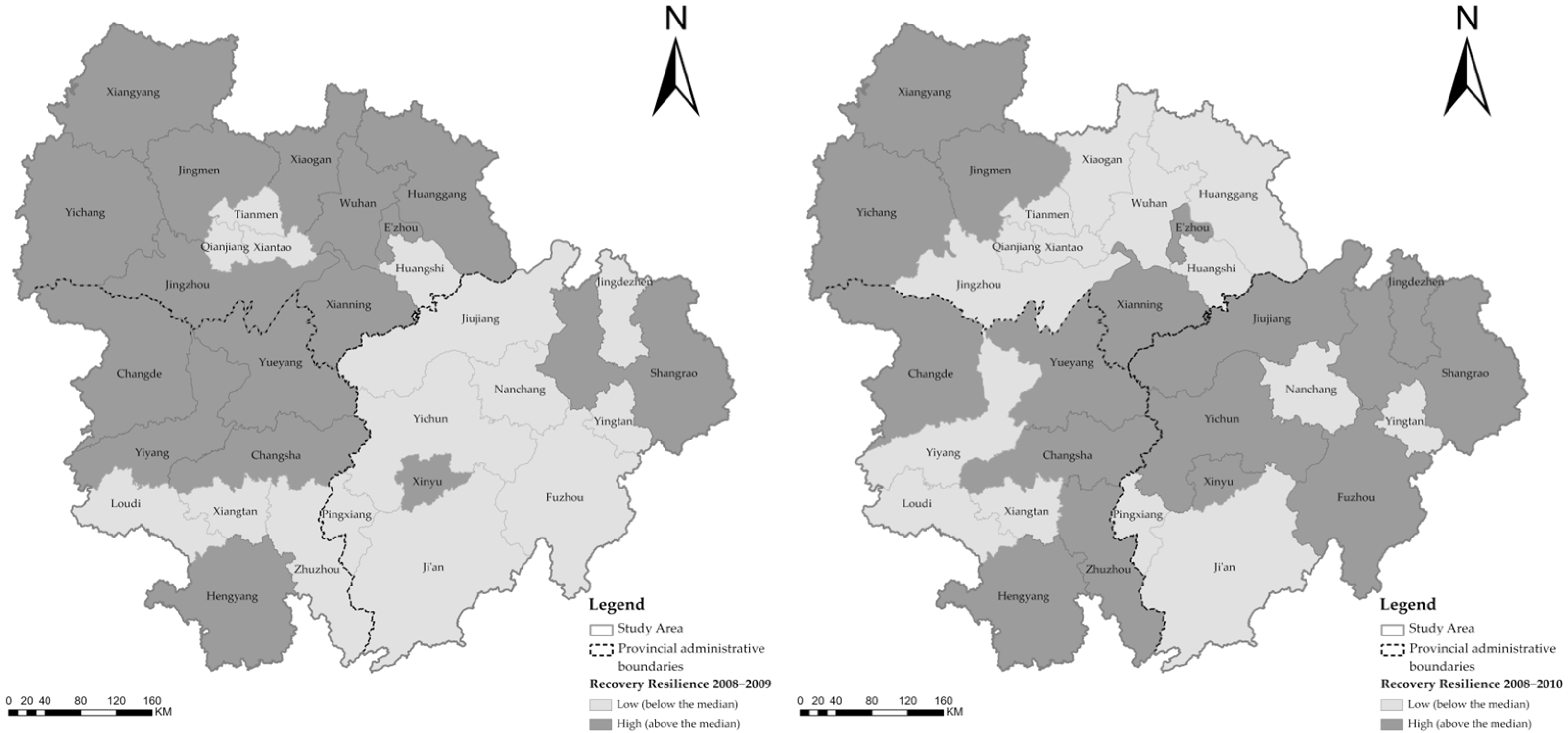
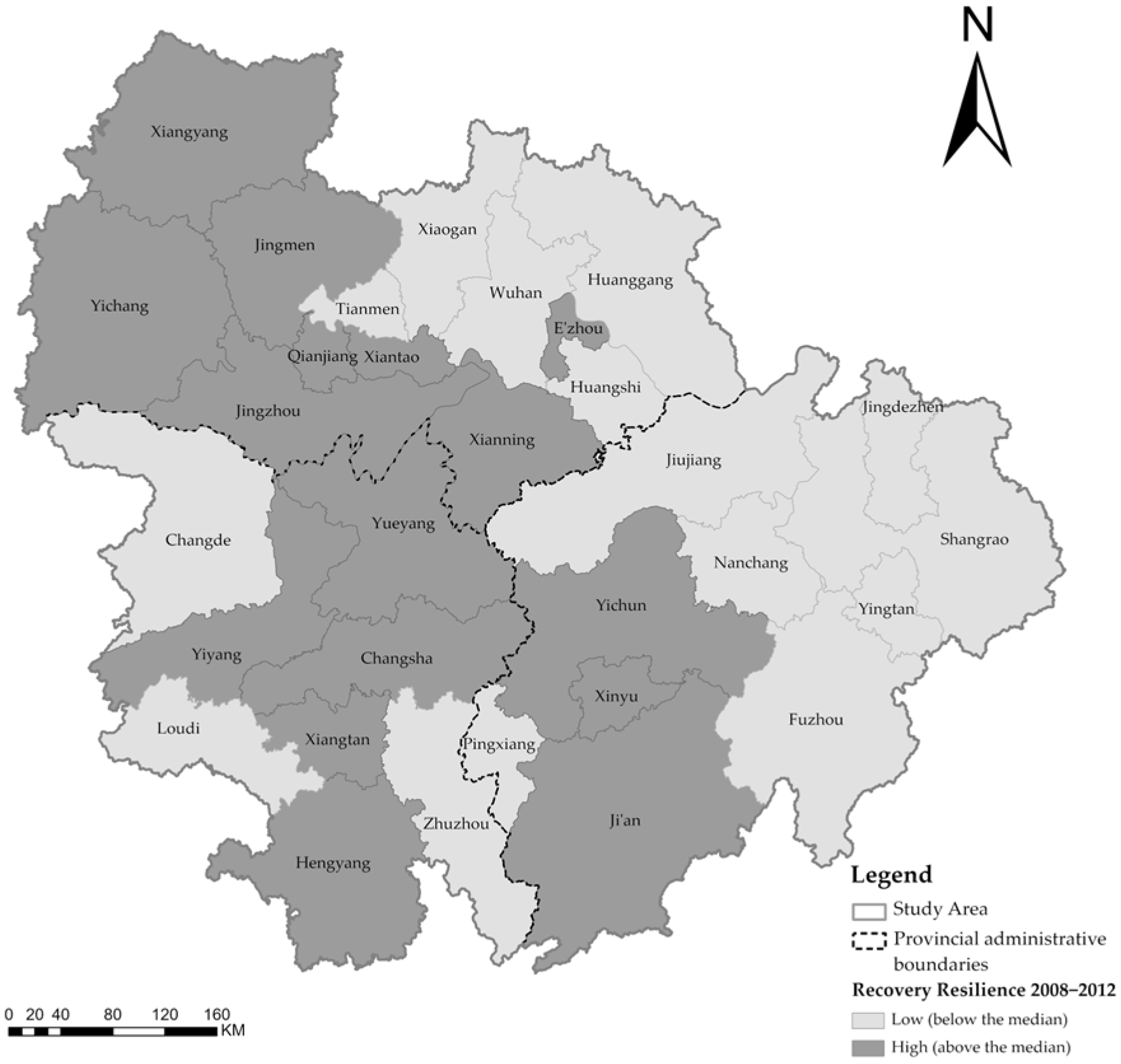
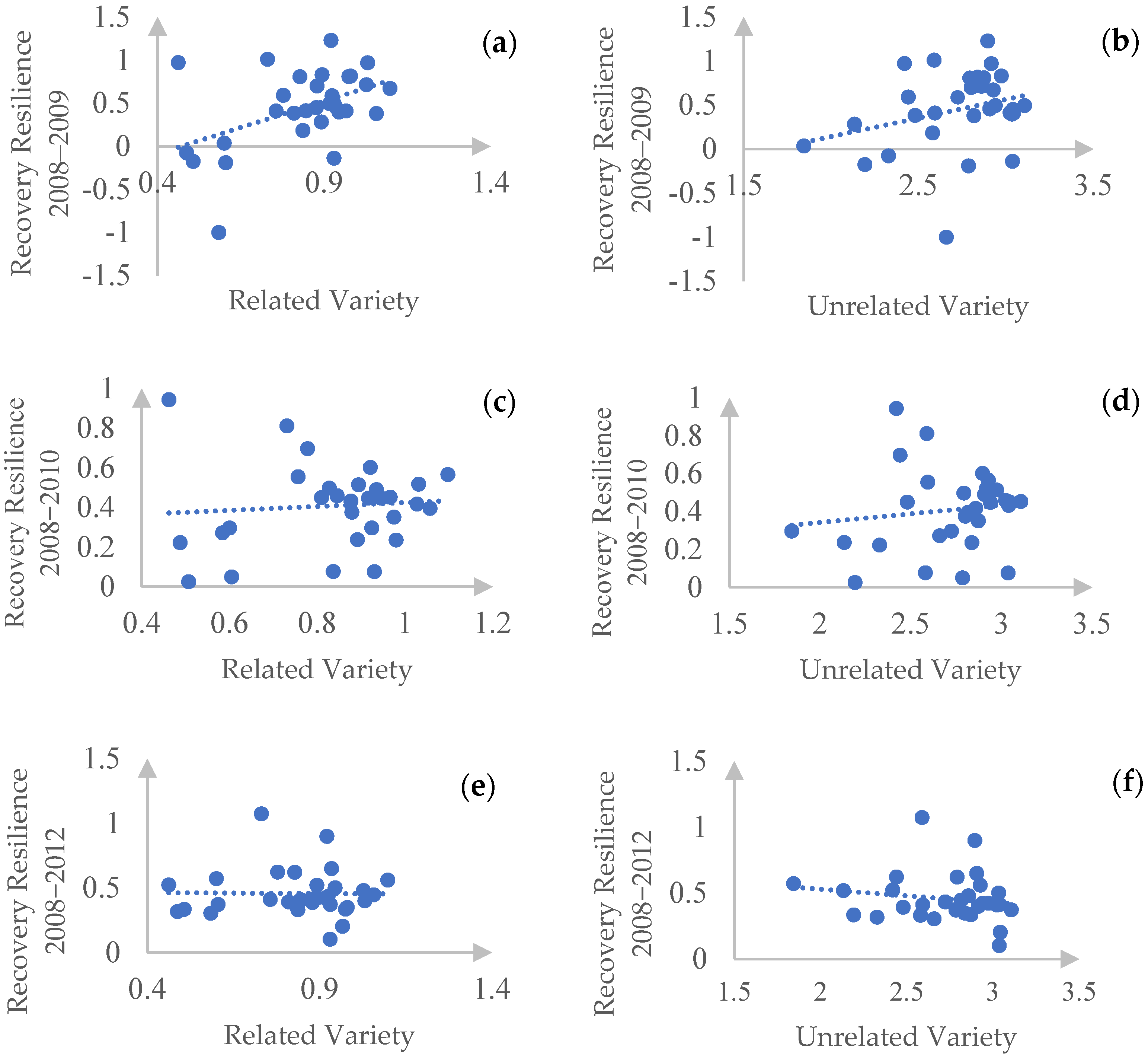
| Mean | S.D. | Max | Min | |
|---|---|---|---|---|
| Recovery resistance 2008–2009 | −0.085 | 0.436 | 1.226 | −0.924 |
| Recovery resistance 2008–2010 | 0.409 | 0.208 | 0.944 | 0.025 |
| Recovery resistance 2008–2012 | 0.458 | 0.185 | 1.074 | 0.102 |
| Related variety | 0.839 | 0.172 | 1.098 | 0.462 |
| Unrelated variety | 2.728 | 0.306 | 3.106 | 1.844 |
| GDP per capita | 20159 | 9533 | 45765 | 9001 |
| Employment | 164,507 | 127,150 | 680,431 | 29,593 |
| Fixed investment | 0.533 | 0.164 | 0.909 | 0.227 |
| Secondary sector | 0.485 | 0.081 | 0.627 | 0.333 |
| No. of Neighbors | SLX | SDM | SDEM | |
|---|---|---|---|---|
| One-year recovery | 2 | 0.0005 | 0.0122 | 0.0006 |
| 3 | 0.1211 | 0.2502 | 0.2579 | |
| 4 | 0.0749 | 0.1112 | 0.1634 | |
| 5 | 0.0002 | 0.0008 | 0.0008 | |
| 6 | 0.0008 | 0.0030 | 0.0025 | |
| Two-year recovery | 2 | 0.0000 | 0.0000 | 0.0000 |
| 3 | 0.0100 | 0.0130 | 0.0132 | |
| 4 | 0.2180 | 0.2673 | 0.4784 | |
| 5 | 0.0000 | 0.0000 | 0.0000 | |
| 6 | 0.0000 | 0.0000 | 0.0001 | |
| Four-year recovery | 2 | 0.0000 | 0.0000 | 0.0000 |
| 3 | 0.0000 | 0.0000 | 0.0002 | |
| 4 | 0.1503 | 0.2097 | 0.5385 | |
| 5 | 0.0002 | 0.0012 | 0.0029 | |
| 6 | 0.0095 | 0.0209 | 0.0665 |
| Recovery 2008–2009 | Recovery 2008–2010 | Recovery 2008–2012 | |
|---|---|---|---|
| Model | SDEM | SDEM | SDEM |
| No. of neighbors | 3 | 4 | 4 |
| Direct effect | |||
| Related variety | 1.736 ** | 3.087 *** | 0.562 |
| Unrelated variety | −0.073 | −2.303 | −0.090 |
| GDP per capita | 0.338 | −2.315 * | −1.935 *** |
| Employment | 0.577 | 1.920 ** | 0.842 ** |
| Fixed investment | 0.211 | 0.622 | 0.293 |
| Secondary sector | 0.892 | 4.959 ** | 2.702 *** |
| Indirect effect | |||
| W × related variety | 4.484 * | 3.723 | 1.228 |
| W × unrelated variety | −7.964 * | −2.220 | −0.756 |
| W × GDP per capita | −0.030 | −5.374 | −3.450 * |
| W × employment | 4.710 *** | 10.030 *** | 4.042 *** |
| W × fixed investment | −3.043 ** | −6.688 *** | −2.264 ** |
| W × secondary sector | 2.313 | 13.423 ** | 3.181 |
| Regional dummies | Yes | Yes | Yes |
| W × regional dummies | Yes | Yes | Yes |
| No. of observations | 31 | 31 | 31 |
| Pseudo R2 | 0.543 | 0.711 | 0.743 |
| λ | 0.591 *** | 0.748 *** | 0.678 ** |
Disclaimer/Publisher’s Note: The statements, opinions and data contained in all publications are solely those of the individual author(s) and contributor(s) and not of MDPI and/or the editor(s). MDPI and/or the editor(s) disclaim responsibility for any injury to people or property resulting from any ideas, methods, instructions or products referred to in the content. |
© 2023 by the authors. Licensee MDPI, Basel, Switzerland. This article is an open access article distributed under the terms and conditions of the Creative Commons Attribution (CC BY) license (https://creativecommons.org/licenses/by/4.0/).
Share and Cite
Li, X.; Chen, J. Global or Local Spatial Spillovers? Industrial Diversity and Economic Resilience in the Middle Reaches of the Yangtze River Urban Agglomeration, China. Sustainability 2023, 15, 11376. https://doi.org/10.3390/su151411376
Li X, Chen J. Global or Local Spatial Spillovers? Industrial Diversity and Economic Resilience in the Middle Reaches of the Yangtze River Urban Agglomeration, China. Sustainability. 2023; 15(14):11376. https://doi.org/10.3390/su151411376
Chicago/Turabian StyleLi, Xiaojing, and Jing Chen. 2023. "Global or Local Spatial Spillovers? Industrial Diversity and Economic Resilience in the Middle Reaches of the Yangtze River Urban Agglomeration, China" Sustainability 15, no. 14: 11376. https://doi.org/10.3390/su151411376
APA StyleLi, X., & Chen, J. (2023). Global or Local Spatial Spillovers? Industrial Diversity and Economic Resilience in the Middle Reaches of the Yangtze River Urban Agglomeration, China. Sustainability, 15(14), 11376. https://doi.org/10.3390/su151411376





